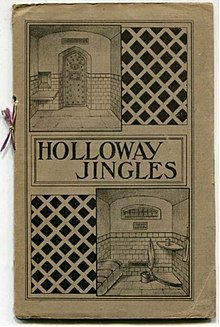Holloway Jingles
 Cover of the poetry collection | |
| Author | WSPU Glasgow branch |
|---|---|
| Genre | Political poetry |
Publication date | 1912 |
Holloway Jingles is a collection of poetry written by a group of suffragettes who were imprisoned in Holloway jail during 1912. It was published by the Glasgow branch of the Women's Social and Political Union(WSPU). The poems were collected and edited by Nancy A John, and smuggled out of the prison by John and Janet Barrowman.[1] The foreword was written by Theresa Gough,[2] a journalist and active speaker for the WPSU, whose nom de plume was ‘Karmie M.T. Kranich'.[3]
The cover depicts two drawings of a bare cell with a check pattern design.[4] It was designed by Constance Moore. The publication was advertised for sale in the newspaper Votes for Women[5] for a cost of 1 shilling. All proceeds of sales went to the WSPU[5]
The poems expressed the imprisoned women's sense of solidarity and subversion, poetry itself having been regarded since the 1830s as a "dangerous form" by traditional educationists.[6] One contributor to the collection was Emily Davison,[7] best known for her death on Epsom Racecourse in campaigning for the vote.[8]
The foreword reads:-
"Comrades, it is the eve of our parting. Those of us who have had the longest sentences to serve have seen many a farewell waved up towards our cell windows from the great prison gate as time after time it opened for release. The jail yard, too, where we exercise, now seems spacious, though at first it was thronged with our fellow prisoners. Yet not one of them has really left us. Whenever in through we re-enter that yard, within its high, grim walls we see each as we knew her there: our revered Leader, Mrs. Pankhurst, courageous, serene, smiling; Dr Ehel Smyth, joyous and terrific, whirling through a game of rounders with as much intentness as if she were conducting a symphony ; Dr L. Garrett Anderson, in whose eyes gaiety and gravity are never far apart - but we cannot name them all, for there are scores who made that yard a pleasant place."[4]
Poems
[edit]- "The Women in prison" by Kathleen Emerson
- "Oh, who are these in scant array", by Kathleen Emerson
- "To a fellow prisoner" (Miss Janie Allan), by anonymous, but thought to be Margaret McPhun[9]
- "There was a small woman called G" by anonymous
- "There's a strange sort of college" by Edith Aubrey Wingrove
- "Before I came to Holloway" by Madeleine Caron Rock
- "Full tide" by AA Wilson
- "Who" by Kate Evans
- "The cleaners of Holloway" by Kate Evans
- "To D.R. in Holloway" by Joan Lavender Bailie Guthrie (Laura Grey) . Thought to be about Dorothea Rock[1][10]
- "Holloway, 8th March" by A Martin
- "The beech wood saunters idly to the sea" by Katherine M Richmond
- "An end" by AA Wilson
- "L'Envoi" by Emily Davison
- "Newington butts were lively" by Alice Stewart Ker
See also
[edit]- Feminism in the United Kingdom
- List of suffragists and suffragettes
- List of women's rights activists
- List of women's rights organizations
- Timeline of women's suffrage
- Women's suffrage organizations
References
[edit]- ^ a b Pickering and Chatto. "Suffragettes" (PDF). Archived from the original (PDF) on 17 November 2022. Retrieved 4 October 2018.
- ^ Christiansen Nelson, Carolyn. Literature of the Women's Suffrage Campaign in England. p. 158.
- ^ Gardner, Viv; Atkinson, Diane (1 March 2019). Kitty Marion: Actor and activist. Manchester University Press. doi:10.7765/9781526138057.00014. ISBN 978-1-5261-3805-7.
- ^ a b "Holloway Jingles". SCRAN. Retrieved 4 October 2018.
- ^ a b "Votes for Women". 31 May 1912.
- ^ Bagüés Bautista, Marta (11 November 2021). "Deeds and Words: The Holloway Jingles and the Fight for Female Suffrage". ES Review. Spanish Journal of English Studies (42): 283–303. doi:10.24197/ersjes.42.2021.283-303. ISSN 2531-1654.
- ^ "Photograph". Museum Wales. Retrieved 21 September 2023.
- ^ "Emily Wilding Davison | suffragette | blue plaques". English Heritage. Retrieved 21 September 2023.
- ^ "A Fellow Prisoner (Miss Janie Allan)". The People's Voice. Retrieved 4 October 2018.
- ^ Crawford, Elizabeth. "Suffrage Stories: 'Laura Grey': Suffragettes, Sex-Poison And Suicide". Woman and her sphere. Retrieved 2 January 2019.


 French
French Deutsch
Deutsch